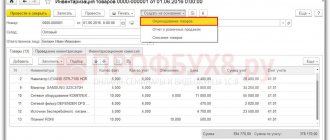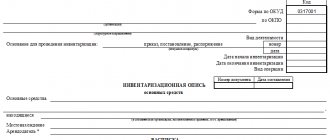Passage mechanism
It all starts with the manager’s order (INV-22 form) to begin this procedure. A commission is selected. It can consist of both the heads of the institution and external auditors or ordinary company employees, specialists in measuring something, etc.
Each financially responsible person first draws up a receipt stating that the material assets under his control are classified and then written off or capitalized (and transferred for inventory). Employees do this in accordance with clause 2.4 of Order of the Ministry of Finance dated June 13, 1995 No. 49.
The commission begins the process on the appointed day. All persons listed in the order must be present, otherwise the entire event may be declared invalid with all the ensuing consequences.
Algorithm of actions
Let's consider the procedure in the form of a step-by-step algorithm.
Step 1. Draw up minutes of the meeting.
Step 2: Remind team members that they are responsible for ensuring that all data is accurate, reliable, and documented.
Step 3. Sign the document drawn up from all members of the EC, starting with its chairman.
Step 4. Submit the signed document to the head of the enterprise for review.
Step 5. Wait for the manager’s decision, which will be drawn up in response to discrepancies identified during the inventory.
Step 6. Submit all materials of the IC work to the accounting service of the enterprise (the results of the audit are reflected in the accounting and reporting of the company based on the order of the head of the enterprise).
Step 7. Keep the documents for at least 5 years.
The purpose of inventory work is to compare the actual availability of valuables with the quantity that appears in official documents in the accounting department.
In this case, both intact goods and materials and those that should be written off or need repair can be identified.
Inventory procedure
The manager always begins the inventory by issuing an order to begin this type of work. In this case, a special commission can be created or one already operating in the organization can be appointed on a permanent basis.
The commission must reflect the data obtained during the inspection in inventories for various purposes, which in turn will be the source for drawing up various acts, such as a write-off act, a disposal act.
Based on the results of such events, the commission holds meetings at which the condition and availability of material valuables, materials, products is reviewed, once a year.
They make proposals to eliminate various deviations in the final indicators, recommend certain measures, identify damaged goods and materials, as well as those responsible for this.
Contents of the inventory commission protocol
Such an inventory act usually contains certain items that correspond to its purpose, namely:
- the name of the organization in which the inventory was carried out and the name of the document;
- an indication of the unit that was inventoried;
- date, locality;
- list of commission members, headed by the chairman;
- description of the results of the inventory;
- a list of persons who spoke on this issue;
- a decision made on an issue on the agenda;
- conclusion of the commission;
- if violations are identified, they are indicated;
- if the guilty persons are identified, then their names and positions are also written down;
- data on the activities that were carried out during the study;
- signatures of all commission members.
The purpose of the inventory is to identify all shortcomings in the quantitative or qualitative characteristics of the company’s material assets, distribute surpluses, investigate the causes of shortages and other activities that are necessary for the normal and efficient functioning of each organization.
It must be said that in the absence of any inconsistencies in the accounting indicators and the actual content of the cases, if no violations and persons responsible for this are identified, then it is absolutely not necessary to draw up such a protocol.
Below is a standard form and a sample inventory protocol, a version of which can be downloaded for free.
Document elements
The paper is based on data from matching statements (inventories) and consists of three parts:
- Document header. Includes OKUD code, filling number, name of the institution.
- Body of the act. It contains data about the members of the commission, the objects directly taken into account, and the deadlines.
- Final part. It contains the signatures of each member of the commission with a transcript and an indication of their positions.
Important point! The statement of discrepancies of form 0504835 is compiled only in the scenario where any surplus or shortage was discovered. If there is full compliance, there is no need to prepare a statement.
Paperwork
Inventory is not just a recalculation of property and checking documents, but also registration of the results. Order No. 49 regulates in detail what needs to be completed and in what order. If property is being inventoried, then it is necessary to carry out an actual check, that is, recalculation or measurement, weighing of the property and enter the data into the inventory list. Based on the results of reconciling the actual result with the accounting data, a comparison sheet is filled out, in which the discrepancies are indicated. The final data is reflected in the statement of results identified by the inventory.
In Order No. 49, the minutes of the meeting of the inventory commission are not listed among the required documents and are mentioned only once - in clause 5.3 of Order No. 49 when considering the issue of reflecting shortages during regrading. Nevertheless, in judicial practice, this document may not only appear, but also be one of the evidence, and for damage not related to regrading. Thus, the absence of a signature and date of drawing up the protocol of the inventory commission served as one of the grounds for refusing the company’s claim for damages from an employee - system administrator in connection with a violation of the procedure for registering inventory results (appeal ruling of the Moscow City Court dated August 14, 2013 in case No. 11- 23913 ).
What assets (values) are inventoried
Each type of value requires the drawing up of an act of the appropriate form. This is described in paragraph 1.2 of the Resolution of the State Statistics Committee of August 18, 1998. So, they distinguish:
An appointed financially responsible person (MRP) is responsible for each unit subject to inspection. Typically, an employee assumes financial responsibility by applying for a job and concluding an appropriate contract.
Fundamentally important! Information about the actual condition of material and other assets is entered into the act in at least 2 copies.
Members of the commission can use all available methods (specified in the Methodological Recommendations) that provide information about the objects being inspected, their quantity and quality.
Registration of inventory results
Based on the results of the inventory, the commission enters the information obtained during the procedure into inventory records (acts). Persons financially responsible are required to attest to the information reflected in the acts (inventories). This is how they confirm their presence during the audit.
To analyze the results of the inventory, the information obtained during the inventory is compared with accounting data. In case of detection of shortages or identification of surpluses, a matching sheet is filled out. It records discrepancies discovered during the audit; data on property or obligations for which there are discrepancies is entered into it. To summarize the inventory for each of the study areas, there is an established form of inventory and statement (for example, inventory list of fixed assets INV-1 and comparison sheet of inventory of fixed assets INV-18).
After comparing inventory and accounting data, a meeting of the inventory commission is held. During the meeting, the results of the inventory are determined, and options for resolving the detected inaccuracies are proposed. The outcome of the meeting is the minutes. The fact of the absence of discrepancies or their presence and the methods of reflection in accounting are recorded in the statement of results. The recommended form of the INV-26 statement is established by Resolution of the State Statistics Committee of March 27, 2000 No. 26.
The protocol and statement are transferred to the head of the organization. Based on the results of their consideration, a final decision will be made.
Reasons for discrepancies
If the actual presence of objects during counting does not coincide with what is documented, then the reason for this may be:
- Defective products that were not written off on time.
- Re-grading.
- With the standard accounting method, there are errors when observing technological write-off standards.
- Making mistakes when registering or writing off.
- Theft.
In each specific case, if there is a discrepancy, a statement of discrepancies should be drawn up and measures should be taken to bring real and documentary information into conformity.
Related documents
The paper will not be valid without:
- An order from management to begin forming a commission. It details the inspection objects, date (or start and end dates), location and persons involved.
- Inventory list. Details for each position will never be superfluous.
- Comparison statement. It is a kind of annex to the previous document.
Contents and sample of filling out the inventory protocol
The standard form of the protocol has not been approved, so each enterprise can develop it independently, taking into account the general requirements for office work. In order for the document to objectively reflect the inventory results and decisions made, it must contain the following basic information:
- Company name.
- Date and place of inspection (locality).
- The structural unit in which the inventory was carried out.
- Composition of the commission.
- Activities carried out during the inspection.
- Results of the inspection.
- List of violations, if any are found.
- Perpetrators, if identified.
- Proposal of the working group based on the results of the inspection.
- List of persons speaking at the meeting and the content of their speeches.
- Decisions made on all issues.
A sample protocol based on the inventory results can be downloaded at the very beginning of the article.
The protocol is signed by all members of the inventory commission. If necessary, documents are attached to it: explanations of responsible persons, decisions of government bodies, etc.
If a mistake is made
Corrections to an already completed paper are acceptable, but they are made in a special way. Incorrect information is crossed out, and correct information is written above it. Then each of the commission members and the financially responsible person must put their signature next to this correction as a sign that they are aware of and agree with the correction.
It is unacceptable to leave any lines of the document blank. If the paper contains more lines than needed, the extra lines are crossed out after the process is completed.
Control
Inventory itself is a form of control. But after its completion, it is possible to carry out control checks of the correctness of the inventory. The number of participants can only expand.
You can begin such a check strictly before the seals on the premises where the initial accounting of resources was carried out are broken.
The results of special control checks are drawn up in the form of a control check of the correctness of the process (form INV-24) and are subject to registration in the book of control checks of the correctness of the process.
Also, in large institutions, unscheduled events may be carried out related to selective accounting of material assets. As for the timing, the inspection is carried out at any time at the discretion of the manager.








